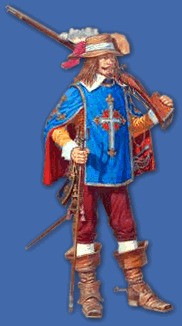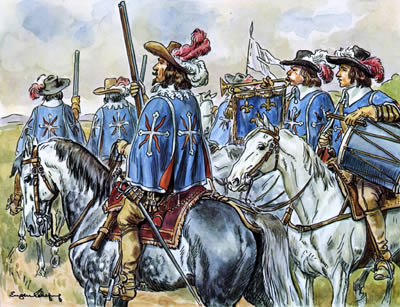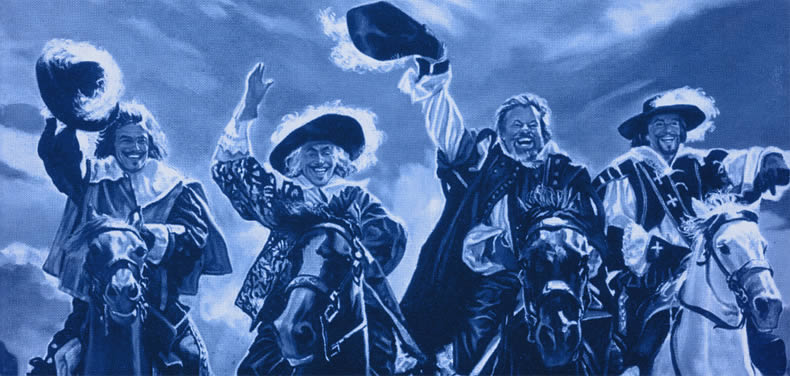This first company of musketeers was created by Louis XIII in 1622.
It was his personal guard, established by his father Henry IV under the name “Carabineers” because these guards carried carbines. Louis XIII replaced the carbines with muskets and it was at this moment that the company became known as the “Musketeers”.
 This took place just after the surrender of the city of Montpellier, as the troops were marching toward Avignon.
This took place just after the surrender of the city of Montpellier, as the troops were marching toward Avignon.
Puységur relates in his memoirs: “His Majesty ordered M. d’Epernon to give him six of his guards to mount the said company. It was his wish, and I can tell you that I was obliged to don the musketeer’s tunic. While it was certainly a great honor to be part of the Company, what troubled me was the idea that I would not be able to assume the commission of ensign that I had been promised in Montpellier in 1622. The King assured me that this was not a demotion, and that he was putting me in the Musketeers because he knew that I was a valiant man who had done great deeds: that he was resolved to put only Gentlemen in this Company that he would take as his Guards along with some soldiers of fortune; but that he didn’t want to take on any men who had not already served and who had not already risen to the occasion…"
Thus, the Company of the Carabineers ceased to exist in favor of a new Company, called the Musketeers, of an entirely different composition, in which the King would only admit noble subjects or persons of known merit.
In creating the company of the Musketeers, Louis XIII wished to form an elite corps of fighters that would be entirely devoted to his person.
Muskets replaced carbines and the blue tunic became the uniform. A strict hierarchy regimented the company according to ranks.
Thus, one should not confuse the appellation of the glorious “Musketeers” with that of the simple soldier who carried and loaded his musket.
To elucidate this difference, Michel Pétard presented the subject in an article entitled “The Musketeer of Rocroi” (Le Mousquetaire de Rocroi):
Some historical background
When Henry IV ascended the throne, he inherited from his predecessor Henry III, assassinated by Jacques Clément at Saint Cloud in 1589, a relatively small military house, body guards, the guards of the Provost Gate, the company of the 100 Swiss, giant halberdiers, and the regiment of the French Guards, created in 1563.
The two hundred gentlemen à bec de corbin [a sort of halberd (1)], unfaithful to their oath, had almost all joined the League. Henry IV, however, would reestablish them once he had entirely reconquered his kingdom (1594) but would only assemble them for grand dynastic ceremonies.
In 1593, he attached the light horse company (carbines), which he had founded while King of Navarre, to his military house. At the same time, he created for his eldest son the “gendarmes of the dauphin”.
Louis XIII, made king by the assassination of his father in 1610, quickly absorbed the gendarmes into his military house (1611).
A warrior-king, in love with the soldiery, military reviews, parades and expeditions, he was to reinforce his Guard, founding the regiment of the Swiss Guards composed of Helvetian veterans loyal to his father (1616), then, in 1622, the company of the hundred musketeers (former carabineers).
E. Bourassin et E. Leliepvre.
(1) The halberd, or halbert, is a shafted, double-bladed weapon, axe-like on one side and beak-like on the opposite side, culminating in a spike at the apex.
Ranks in the Company of the Musketeers
Adapted from Alfred Jensen
The Officers
In addition to the privileges of their rank, all officers are exempt from royal taxes. Indeed, by their very presence on the battlefield, they are considered to have already paid a “blood tax”.
-The Lieutenant-Captain
He commands the company. He can voluntarily propose the services of his company for a campaign or assign personal missions to some of his men, etc. In the past, officers’ commissions in the Musketeers and the Guards were for hire, the grade of lieutenant-captain sold at 200,000 pounds and the other commissions sold proportionally. Thereafter, Louis XIII would favor a system of promotions according to merit.
-The Sub-Lieutenant
He is the direct assistant to the Lieutenant-Captain of the company
-Cornette (Standard-Bearer) and Ensign
It is the lowest grade of officer. One of his roles is to represent and rally the men of the company during battle.
The rank and file
-Maréchal des Logis (Chief Sergeant):
the superior grade of the rank and file
-Corporal: the intermediaries among the ranks men
-Gendarmes, Light-Horses and Musketeers:
the lowest ranks of the companies
La Company
 “The company combats on foot and on horseback, the men all dressed differently but all wear over their clothing –as a distinctive sign—the blue tunic, which is very short because it hangs just to the horse’s croup. It’s a sort of pelerine with broad, open sleeves upon which appear four white crosses: one on each side, one on the front, one on the back. The sight of these blue [tunics] with their white crosses terrorized their adversaries, such was the fighting skill and bravery of the musketeers!”
“The company combats on foot and on horseback, the men all dressed differently but all wear over their clothing –as a distinctive sign—the blue tunic, which is very short because it hangs just to the horse’s croup. It’s a sort of pelerine with broad, open sleeves upon which appear four white crosses: one on each side, one on the front, one on the back. The sight of these blue [tunics] with their white crosses terrorized their adversaries, such was the fighting skill and bravery of the musketeers!”
Clément Bosson
“The first company didn’t have a uniform for quite some time, but whenever the King desired to pass a review with pomp, he would order his musketeers to be outfitted in a particular fashion. Once, having ordered the company to dress leather, the richest musketeers decorated their sleeves with a quantity of diamonds; another time, he ordered them to clothe themselves in black.”
Jean de Jaurgain
“(…) the Gascons remained a real force among the troops. Aside from the lesser nobility, the royal army also promoted valiant commoners. Gassion, Marshal of France, and Treville, both merchants’ sons from Oloron, illustrate this. The Gascon warriors-in-training had, especially in the regiment of the French Guards, an authentic and almost exclusive military training. At least in the beginning, eight out of ten companies were commanded by captains from Gascony. At the same time, as new regiments formed, they took the name of their owner which often happened to be the name of a Gascon family. Under the reign of Louis XIII the formation of the Company of the King’s Musketeers became a real attraction for young gentlemen desiring to learn, in this elite troupe, the soldier’s trade and at the same time the duties of a member of the court. In this way one can legitimately maintain the existence of a sort of Gascon mafia that monopolized the governorships and lieutenancies in the provinces, military commands, as well as royal offices and court appointments.”
Véronique Larcade
Therefore, it is not surprising that Dumas, in his narrative of the history of the Musketeers, dotes d’Artagnan, his Gascon hero, with a fatherly recommendation for Monsieur de Tréville, also a Gascon and Captain of the Musketeers.
Upon creation of the first company, Monsieur de Montalet was named its commanding captain. He then died –poisoned, as de Puysegur writes in his memoirs—and was succeeded by another Monsieur de Montalet, his nephew, previously the company’s standard-bearer.
In 1627, it is the same Montalet who would lead the Musketeers to the rescue of the Isle of Ré.
This was to be the first major battle waged by the new company, followed soon after by the siege of La Rochelle.
“The English having sent a considerable fleet to aid the Calvinists of France in their campaign to conquer the isle of Ré in 1627, Louis XIII arrived with his army in the province of Aunis to oppose them and at the same time punish the rebels. On 8th November, he dispatched the Company of the Musketeers to defend the island. The Prince’s success on this occasion encouraged him to lay siege to La Rochelle, a bridgehead for Calvinism. The city mounted a long and vigorous resistance and sought aid from all quarters. In particular, the rebellious city was able to count on the aid of the English, whose fleet appeared off the French coast on 16th May 1628. Louis XIII having been informed of this, immediately sent his musketeers to Marshall de Bassompierre with the order to have them board the English ships, which was done. The English advanced but, after having fired all their cannon, they turned around and did not reappear.”
Le Thueux
Cardinal Richelieu was so impressed by the musketeers’ fighting vigor and valor that he decided to send them on every campaign where a small elite troop might be effective.
“Richelieu was able to verify the excellence of his decision the very next year. The king of Spain and the Duke of Savoy both claimed sovereignty over the marquisate of Montferrat and had laid siege to Casal. In light of the capture of La Rochelle, the King’s Council was able to dissuade Louis XIII from compromising his prestige by abandoning Prince Charles Gonzaga, his ally. The King left Paris for Savoy on 15th January 1629, accompanied by his Guards and the Musketeers. The Cardinal and an imposing general staff traveled with him.”
Arnaud Jacomet.
“(The King) sent an emissary to the Duke of Savoy on the 6th March to request the right of passage for his troops. This request having been denied, it was decided to force a passage in the Suze Pass, which the Duke of Savoy and the Prince of Piedmont were both defending personally. The preparations having been made, seven companies of the French Guards, six companies of the Swiss Guards, the King’s Musketeers on horseback and various other companies were sent into the gorge to begin the attack. It was decided that each corps should send forward fifty infantrymen (the Enfants-perdus), and Louis XIII ordered his Musketeers to march with the infantry and the Guards. The King said on this occasion that what pleased him so much about his Musketeers was this famous gaiety with which they executed any order.

They advanced under the fire of the enemies positioned on the mountains and bore the canon-fire from the fort of Talasse. Arriving , their swords in their hands, at the first line of defense, they fell upon the Piedmont men, shoving them backwards and attacking them so vigorously that they swept away two other barricades with the same speed, entering with the fleeing enemy. They climbed without stopping to the top of the mountain, with a view over Suze, from which the citadel fired a barrage of cannon balls.”
Le Thueux
This was one of the occasions where Monsieur de Tréville showed his bravery and pugnacity by pursuing the fleeing Duke of Savoy, which earned him the grade of lieutenant in the Company of the Musketeers.
In the end, victory was total. On 11th March, Suze and its castle capitulated and Louis XIII couldn’t have been more proud of his musketeers.
“The Company’s prestige in the army and among the young nobility rose considerably. One began to think that it would be more valiant to risk dying in the “bed of honor”, as it was called in those days, wearing the musketeer’s tunic rather than as a member of the Guards. This new state of mind was particularly apparent among the Gascons, a lean and sober race for whom the military trade was their exclusive religion.”
Arnaud Jacomet
“The Company’s prestige in the army and among the young nobility rose considerably. One began to think that it would be more valiant to risk dying in the “bed of honor”, as it was called in those days, wearing the musketeer’s tunic rather than as a member of the Guards. This new state of mind was particularly apparent among the Gascons, a lean and sober race for whom the military trade was their exclusive religion.”
Le Thueux
In fact, Monsieur de Montalant, commanding captain of the company of the Musketeers, resigned in 1634 and Louis XIII decided to name himself Captain.
Some say that the king wanted to assume personal leadership of the Musketeers in order to reinforce the company’s prestige. Accordingly, he would have asked for Montalant’s resignation, consoling the latter with the military governorship of the Duchy of Savoy and the city of Bar.
He named Tréville lieutenant, and from that moment the commander of the company no longer held the title of Captain but “Captain-Lieutenant”.
“The Musketeers were hardly surprised to learn that the King was placing himself at their head: His Majesty had convinced them long ago of his interest in their daily life, in never missing a review and in having the new recruits presented to him.”
Arnaud Jacomet
This first company had its quarters at 15, rue du Bac. The musketeers were considered part of the King’s House and not part of the military house. Therefore, at the Court, they were at the service of the King and no one else. When they accompanied the King, they proceeded on horseback, two by two, ahead of the other companies of Guards.
“The mounted Musketeers of the King’s guard only mount the guard when the King goes out; they then proceed on horseback before all the other Guards, two by two. They all wear the blue tunic with the silver cross. Their captain is Monsieur de Tréville, which the defunct King had promoted to this position because of his great courage. They are one hundred thirty men and receive forty sols per day.”
(“The State of France in 1648 – 1649” – F. Danjou. Archives, Curiosities of the History of France, series 2, t. VI, p.432)
When they were at war, the Musketeers were lodged in the King’s quarters and fought alongside the King in close quarters.
Their prestige was so great, it is no wonder that most young men of that time dreamt of joining the Musketeers. But the number of Musketeers being limited, many had no choice but to settle for the other corps of the army.
It appears that from 1636 to 1646, the Musketeers did not participate systematically in all the campaigns, whether in Lorraine, Picardy or in Flanders, because the King treasured them so much that he didn’t wish to sacrifice them.
It is for that reason, therefore, that so few losses were reported and that the number of recruits was so small. “Happily, the King and Troisvilles ensured that the other cadet companies and the Royal Academy for the Nobility created by Richelieu to compete [with the Musketeers] remained open.”
Arnaud Jacomet

